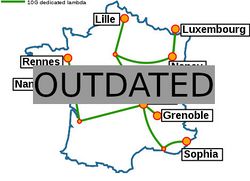Grid5000:Home: Difference between revisions
Ddelabroye (talk | contribs) No edit summary |
No edit summary |
||
| Line 7: | Line 7: | ||
Key features: | Key features: | ||
* provides '''access to a large amount of resources''': 1000 nodes, 8000 cores, grouped in homogeneous clusters, and featuring various technologies: 10G Ethernet, Infiniband, GPUs, Xeon PHI | * provides '''access to a large amount of resources''': 1000 nodes, 8000 cores, grouped in homogeneous clusters, and featuring various technologies: 10G Ethernet, Infiniband, Omnipath, GPUs, Xeon PHI | ||
* '''highly reconfigurable and controllable''': researchers can experiment with a fully customized software stack thanks to bare-metal deployment features, and can isolate their experiment at the networking layer | * '''highly reconfigurable and controllable''': researchers can experiment with a fully customized software stack thanks to bare-metal deployment features, and can isolate their experiment at the networking layer | ||
* '''advanced monitoring and measurement features for traces collection of networking and power consumption''', providing a deep understanding of experiments | * '''advanced monitoring and measurement features for traces collection of networking and power consumption''', providing a deep understanding of experiments | ||
Revision as of 08:25, 17 September 2018
|
Grid'5000 is a large-scale and versatile testbed for experiment-driven research in all areas of computer science, with a focus on parallel and distributed computing including Cloud, HPC and Big Data. Key features:
Older documents:
|
Random pick of publications
Five random publications that benefited from Grid'5000 (at least 2927 overall):
- Maxime Agusti, Eddy Caron, Benjamin Fichel, Laurent Lefèvre, Olivier Nicol, et al.. PowerHeat: A non-intrusive approach for estimating the power consumption of bare metal water-cooled servers. 2024 IEEE International Conferences on Internet of Things (iThings) and IEEE Green Computing & Communications (GreenCom) and IEEE Cyber, Physical & Social Computing (CPSCom) and IEEE Smart Data (SmartData) and IEEE Congress on Cybermatics, Aug 2024, Copenhagen, Denmark. pp.1-7. hal-04662683 view on HAL pdf
- Ismaël Tankeu, Geoffray Bonnin. Towards Characterising Induced Emotions: Exploiting Physiological Data and Investigating the Effect of Music Familiarity. MuRS 2024: 2nd Music Recommender Systems Workshop, Oct 2024, Bari, Italy. hal-04703972 view on HAL pdf
- Quentin Guilloteau, Florina M Ciorba, Millian Poquet, Dorian Goepp, Olivier Richard. Longevity of Artifacts in Leading Parallel and Distributed Systems Conferences: a Review of the State of the Practice in 2023. REP 2024 - ACM Conference on Reproducibility and Replicability, ACM, Jun 2024, Rennes, France. pp.1-14, 10.1145/3641525.3663631. hal-04562691 view on HAL pdf
- Gautier Evennou, Vivien Chappelier, Ewa Kijak, Teddy Furon. SWIFT: Semantic Watermarking for Image Forgery Thwarting. WIFS 2024 - 16th IEEE International Workshop on Information Forensics and Security, IEEE, Dec 2024, Roma, Italy. pp.1-6. hal-04728070 view on HAL pdf
- Jolan Philippe, Antoine Omond, Hélène Coullon, Charles Prud'Homme, Issam Raïs. Fast Choreography of Cross-DevOps Reconfiguration with Ballet: A Multi-Site OpenStack Case Study. SANER 2024: IEEE International Conference on Software Analysis, Evolution and Reengineering, Mar 2024, Rovaniemi, Finland. pp.1-11, 10.1109/SANER60148.2024.00007. hal-04457484 view on HAL pdf
Latest news
Failed to load RSS feed from https://www.grid5000.fr/mediawiki/index.php?title=News&action=feed&feed=atom: Error parsing XML for RSS
Grid'5000 sites
Current funding
As from June 2008, Inria is the main contributor to Grid'5000 funding.
INRIA |
CNRS |
UniversitiesUniversité Grenoble Alpes, Grenoble INP |
Regional councilsAquitaine |


